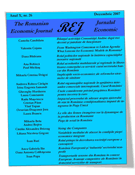Abstract:
The objective of the study was to explore the role of export diversification in poverty reduction strategies following recent growth of non-traditional exports and its perceived potential to contain poverty in Tanzania. Real income per capita growth was used to proxy poverty reduction. Applying Toda and Yamamoto (1995) causality test model on time series yearly data (1980-2015), the results show the existence of a uni-directional causal relationship between horizontal export diversification and income per capita growth in Tanzania. The relationship between vertical export diversification and income per capita growth was found to be insignificant. The possible explanation is country’s weak industrial base. Drawing lessons from East Asia and some other African countries, it was found that deep horizontal export diversification and vertical export diversification were significant factors in enhancing income per capita growth. However, in East Asia income per capita growth led by vertical export diversification was more impressive than that of horizontal export diversification in addressing poverty. Thus, the study argues that export diversification could contribute towards poverty reduction initiatives in Tanzania. However, to enable it generate significant impacts in form of reduced poverty an integrated package of policies and strategies need to be put in place in order to spearhead both deep horizontal and vertical export diversifications in Tanzania.
